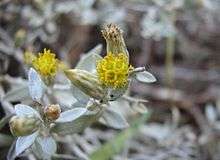Acanthocladium
| Acanthocladium | |
|---|---|
 | |
| Scientific classification | |
| Kingdom: | Plantae |
| (unranked): | Angiosperms |
| (unranked): | Eudicots |
| (unranked): | Asterids |
| Order: | Asterales |
| Family: | Asteraceae |
| Genus: | Acanthocladium F.Muell.[1] 1861 not Mitt. 1883 (Sematophyllaceae, a moss) |
| Species: | A. dockeri |
| Binomial name | |
| Acanthocladium dockeri F.Muell. | |
| Synonyms[2] | |
|
Helichrysum dockeri (F.Muell.) Benth. | |
Acanthocladium dockeri is a critically endangered species of the Asteraceae family that belongs to the monotypic genus Acanthocladium. It is commonly known as spiny everlasting or spiny daisy. It is native to Australia, and is found around the South Australian town of Laura.[3]
Description
The Spiny everlasting is a woody perennial shrub with spines at branch ends, covered in short white hair. It bears oblong, bumpy fruit.
Spiny everlasting was presumed extinct in 1992, having suffered habitat loss from clearance for winter crops, but various colonies of it have been found around Laura, near the Spencer Gulf.
Homonym
In 1883, William Mitten used the same name, Acanthocladium, to refer to a group of mosses, now in the family Sematophyllaceae.[4] Several dozen species of mosses were described and place in this genus before it was realized that Mittenn's name represented an illegitimate homonym.[5] The moss genus has since been renamed Wijkia H.A. Crum.[6][7]
References
- ↑ "Acanthocladium". Australian Plant Name Index (APNI), IBIS database. Centre for Plant Biodiversity Research, Australian Government, Canberra. Retrieved 2 March 2012.
- ↑ The Plant List, Helichrysum dockeri (F.Muell.) Benth.
- ↑ http://www.environment.gov.au/cgi-bin/sprat/public/publicspecies.pl?taxon_id=17632
- ↑ Mitten, William. 1883. Proceedings of the Linnean Society of New South Wales 7: 102 in Latin.
- ↑ The Plant List, search for Acanthocladium
- ↑ Crum, Howard Alvin 1971. Nomenclatural changes in the Musci. The Bryologist 74(2): 165–174
- ↑ Tropicos Acanthocladium Mitt.
